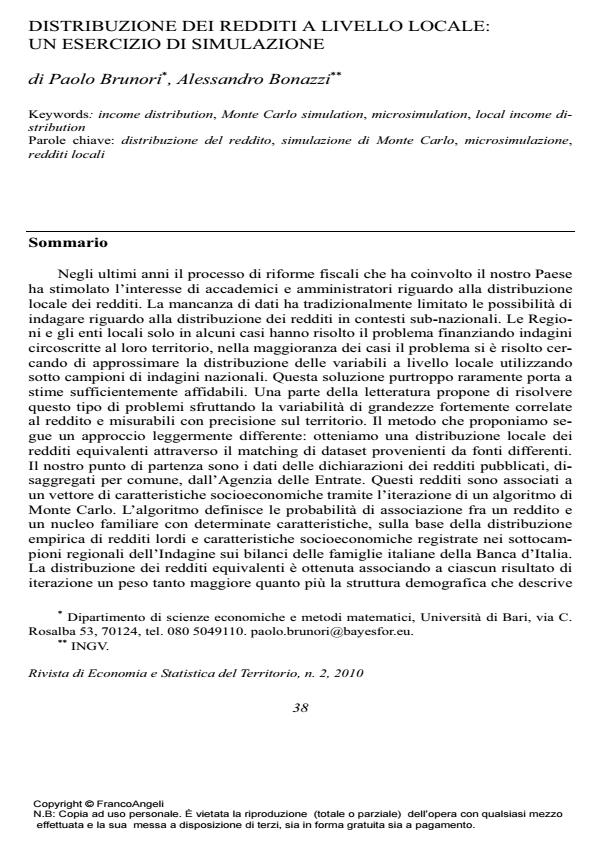Distribuzione dei redditi a livello locale: un esercizio di simulazione
Titolo Rivista RIVISTA DI ECONOMIA E STATISTICA DEL TERRITORIO
Autori/Curatori Paolo Brunori, Alessandro Bonazzi
Anno di pubblicazione 2010 Fascicolo 2010/2
Lingua Italiano Numero pagine 16 P. 38-53 Dimensione file 331 KB
DOI 10.3280/REST2010-002002
Il DOI è il codice a barre della proprietà intellettuale: per saperne di più
clicca qui
Qui sotto puoi vedere in anteprima la prima pagina di questo articolo.
Se questo articolo ti interessa, lo puoi acquistare (e scaricare in formato pdf) seguendo le facili indicazioni per acquistare il download credit. Acquista Download Credits per scaricare questo Articolo in formato PDF

FrancoAngeli è membro della Publishers International Linking Association, Inc (PILA)associazione indipendente e non profit per facilitare (attraverso i servizi tecnologici implementati da CrossRef.org) l’accesso degli studiosi ai contenuti digitali nelle pubblicazioni professionali e scientifiche
Negli ultimi anni il processo di riforme fiscali che ha coinvolto il nostro Paese ha stimolato l’interesse di accademici e amministratori riguardo alla distribuzione locale dei redditi. La mancanza di dati ha tradizionalmente limitato le possibilità di indagare riguardo alla distribuzione dei redditi in contesti sub-nazionali. Le Regioni e gli enti locali solo in alcuni casi hanno risolto il problema finanziando indagini circoscritte al loro territorio, nella maggioranza dei casi il problema si è risolto cercando di approssimare la distribuzione delle variabili a livello locale utilizzando sotto campioni di indagini nazionali. Questa soluzione purtroppo raramente porta a stime sufficientemente affidabili. Una parte della letteratura propone di risolvere questo tipo di problemi sfruttando la variabilità di grandezze fortemente correlate al reddito e misurabili con precisione sul territorio. Il metodo che proponiamo segue un approccio leggermente differente: otteniamo una distribuzione locale dei redditi equivalenti attraverso il matching di dataset provenienti da fonti differenti. Il nostro punto di partenza sono i dati delle dichiarazioni dei redditi pubblicati, disaggregati per comune, dall’Agenzia delle Entrate. Questi redditi sono associati a un vettore di caratteristiche socioeconomiche tramite l’iterazione di un algoritmo di Monte Carlo. L’algoritmo definisce le probabilità di associazione fra un reddito e un nucleo familiare con determinate caratteristiche, sulla base della distribuzione empirica di redditi lordi e caratteristiche socioeconomiche registrate nei sottocampioni regionali dell’Indagine sui bilanci delle famiglie italiane della Banca d’Italia. La distribuzione dei redditi equivalenti è ottenuta associando a ciascun risultato di iterazione un peso tanto maggiore quanto più la struttura demografica che descrive corrisponde a quella realmente registrata dall’Istat per il territorio considerato. Per mostrare limiti e potenzialità del metodo riportiamo un’applicazione per due province italiane: Bari e Foggia.
Jel codes:C81, R12
Paolo Brunori, Alessandro Bonazzi, Distribuzione dei redditi a livello locale: un esercizio di simulazione in "RIVISTA DI ECONOMIA E STATISTICA DEL TERRITORIO" 2/2010, pp 38-53, DOI: 10.3280/REST2010-002002